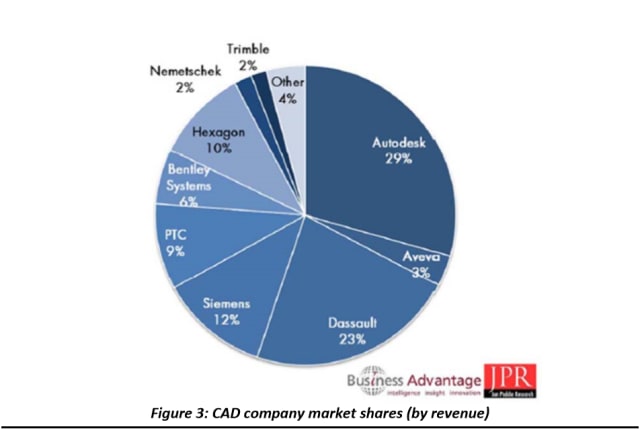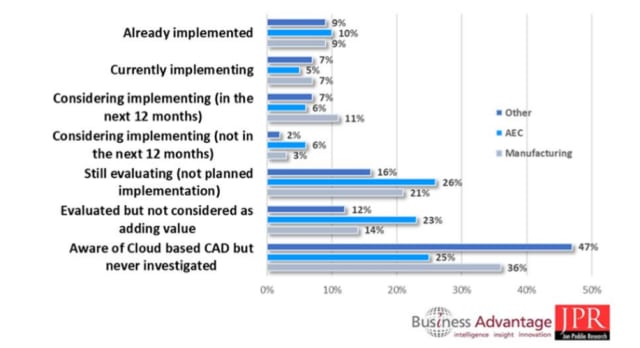
Is the trend towards cloud-based CAD more beneficial towards CAD vendors or their customers? (Image courtesy of JPR and Business Advantage.)
When Autodesk announced that it would be moving some of its major software products to the cloud in 2015, a reactionary backlash began from some of the more vocal content creators who use their software on a regular basis. The transition from perpetual licenses to subscriptions was justified by the company in order to make recurring payments more predictable, to increase the rate of new users signing up and to decrease piracy by using cloud subscription verification processes.
Fastforward to today, and every CAD vendor now has plans for the cloud. We’ve seen the rise of Onshape, a CAD program that runs completely within your browser, making it an extremely powerful mobile CAD platform. Autodesk has consistently developed Fusion 360, though it is only partially cloud based, requiring a relatively sophisticated GPU and part of your workstation’s hard drive.
So, here’s question for CAD companies: Are CAD users warming up to the idea of cloud-based subscription models? After all, the concern is understandable. When your business’ vital software is moved to the cloud, you have less control over it. What can users do about it really? CAD vendors like Autodesk and Dassault Systèmes are taking more aggressive actions to segment and partition more services away from the perpetual license model to the new cloud subscription models.
For CAD vendors, customer feedback is crucial towards avoiding mistakes that can be extremely costly, such as long-time customers bailing out and looking for alternatives that are not cloud-based subscriptions. How do serious professionals feel about CAD in the cloud?
Recently, I was able to look at 17 pages of a 101-page report called “CAD In the Cloud,” which showed the results of about 200 professionals who use software from CAD vendors to produce work in a diverse array of global industries.
Who produced this report?
Jon Peddie Research (JPR) is a graphics marketing and management consulting firm that helps clients with strategic analysis, special reports and new product evaluations, among other things. It teamed up with international B2B marketing research company Business Advantage, which was formed in 1992. Business Advantage performs research, data services, marketing and consulting in the global IT and telecommunications industries with a special focus on CAD, computer-aided manufacturing (CAM), computer-aided engineering (CAE), product lifecycle management (PLM), product data management (PDM), virtual reality, augmented reality and 3D printing. The company has completed 650 projects in 100 countries and counts Autodesk, Microsoft, Facebook, Oracle and IBM among its clients.

JPR and Business Advantage have formulated the data from their survey to create, execute and tally the results from a survey designed to understand how CAD users feel about the emergence of cloud-based subscriptions to create the “CAD In the Cloud” report.
Who were the survey participants in the report?
There were about 1,000 CAD users and decision makers who showed interest in the survey, but only those using an in-house CAD system and who were aware of or using cloud-based CAD could participate. This left 203 qualified people who completed the full survey.
With 203 completions, the authors of the report say that they have statistically reliable results for responses in big sample groups, including architecture, engineering and construction and manufacturing. The same statistical reliability can be applied to attitudes in different geographical regions, but not to sample sizes of less than 50 participants, which are more indicative of results or trends.
Who was this report created for?
This report was created for product, development and marketing managers of software vendors, hardware vendors and system integrators who work in CAD, CAM, PLM and PDM sectors. It is also meant for the eyes of design, engineering and CAD executives and managers as well as research professionals and analysts.
The broad group of professionals represent a cross-section between major industries who rely on the work of engineers, architects, designers and others. The report is designed to provide insight into how these professionals perceive the trend of cloud-based CAD software and computing.
The report covers feedback about this important topic by industry, geographical location, company size and level of decision-making authority.
What does “CAD in the cloud” mean for this report?
According to the report, JPR and Business Advantage defined “CAD in the cloud” as “a model where software applications are delivered to the user over the Internet (i.e. software is not stored on the company’s network, desktop PC, laptop, etc.).”
What questions were asked and answered in the report?
- What are the current and future usage plans for CAD in the cloud?
- Which companies do users perceive as the leading CAD in the cloud vendors?
- What is the perceived importance of CAD in the cloud?
- What is the benefit perception vs. reality of CAD in the cloud?
- Who are the perceived enablers and inhibitors of CAD in the cloud?
What are the evolving management and infrastructure approaches to CAD in the cloud?What do people think are necessary hardware considerations for CAD in the cloud?
What are some insights from the report?
Those surveyed are aware that nearly all CAD vendors have their eyes on the cloud, but realistically do not expect the totality of their customers to abandon everything else for cloud-based CAD.

The chart above shows how different sectors are implementing and planning to implement cloud-based CAD. They are all pretty even, with manufacturing coming out on top by a small margin.
General Conclusion From the CAD in the Cloud Survey
The results of the survey gave the creators strong indications that the willingness to adopt CAD in the cloud is actually higher than most would assume. CAD software vendors are confident that the benefits of cloud-based subscriptions outweigh the perils for customers, and in the long run, CAD in the cloud will be more profitable for them and protect them against people burning and sharing their software, which happened quite a bit over the last two decades.
This passage from the report sums it up nicely: “CAD/CAM/CAE users are at the early stages of cloud-based workflows. Software vendors are confident of the benefits of leveraging the cloud and are developing products for their customers. However, there is a mismatch in definitions and expectations between customers and vendors, causing an adoption delay, but we are seeing customer attitudes change very quickly from entrenched positions to acceptance.”
via Andrew Wheeler at Engineering.com
